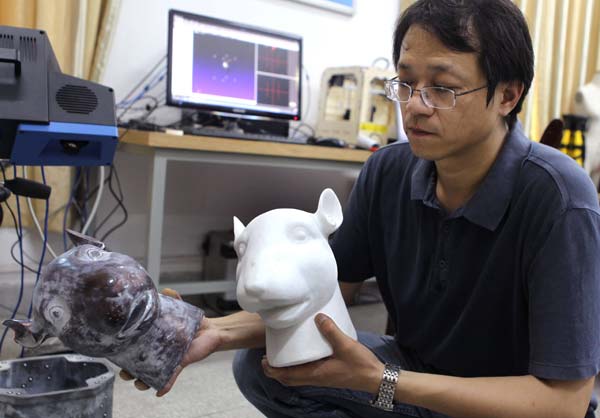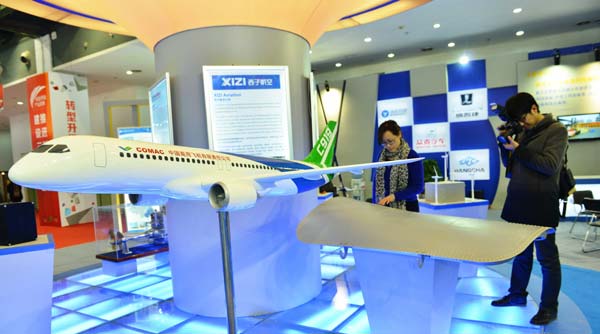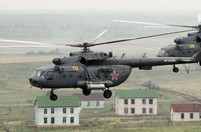 Chinese Air Force's combat group organizes actual-combat training
Chinese Air Force's combat group organizes actual-combat training How do politicians and royal families spend holidays?
How do politicians and royal families spend holidays?
 Heilongjiang issues orange alert for severe flood
Heilongjiang issues orange alert for severe flood
 Migrating flamingos gather in Kenyan lake for food
Migrating flamingos gather in Kenyan lake for food
 India launches first indigenous aircraft carrier
India launches first indigenous aircraft carrier
 Prisoners take wedding dress photos to welcome Qixi festival
Prisoners take wedding dress photos to welcome Qixi festival
 Zhou Dongyu promotes 'The Palace' in Beijing
Zhou Dongyu promotes 'The Palace' in Beijing
 Questioning China's real achievements
Questioning China's real achievements
 'Super Dan' wins Olympic final rematch
'Super Dan' wins Olympic final rematch
 |
| Zhou Gang, a doctoral candidate in material science at Huazhong University of Science and Technology, holds an animal head sculpture in his right hand and a replica made through 3-D printing in his left. Photo by Guan Xin / China Daily |
Special printers used to produce objects by following a computer blueprint in 'additive manufacturing', Cheng Yingqi reports.
A new industrial process is taking off in the Chinese aviation industry as scientists and industrialists exploit its advantages in the research and manufacture of commercial and military aircraft.
Industry sources said 3-D printing technology has found its way into the production of titanium alloy airframes, landing gear and engine parts, such as turbine blades and disks.
On the C919, China's first domestically designed commercial aircraft, scientists used 3-D printing technologies to design the plane and are now actively exploring production techniques.
The C919 is a narrow-body airliner being built by the Commercial Aircraft Corporation of China.
Industry experts expect the plane, which will have seating for 158 to 174 passengers, to be China's answer to the Boeing 737 and the Airbus A320.
The 3-D design process means the aircraft may burn 12 to 15 percent less fuel than its foreign peers and could reduce operating costs by 10 percent.
In addition to the C919, 3-D printing technology has been used in the manufacture of parts for COMAC's Advanced Jet 21 regional jet, which has been making trial flights since 2009, according to the Beijing-based China Aviation News.
Xi'an Aircraft Industry (Group) Co has established a team to conduct research into the application of 3-D printing techniques in precision casting, which has helped accelerate the development cycle, the paper said.
Quick and inexpensive
Also called "additive manufacturing", the process uses special printers to produce a 3-D object by following a computer blueprint. Essentially, the digitized information is fed into a computer, which then controls printer nozzles and sprays layer upon layer of the raw material onto a manufacturing bed to produce a three-dimensional representation of the information. The materials are then fused to create the finished product.
While conventional techniques may take weeks to produce a single component, 3-D printing can complete the task much more quickly.
"With 3-D printing technology, you can produce sophisticated aviation industry components in just half the time and at half the expense of traditional manufacturing methods," said Lu Bingheng, a member of the Chinese Academy of Engineering and a leading light in the field of machinery manufacture and automation.
"As the C919 is still under development, the technology remains scientific exploration. More research should be conducted to ensure the quality of civil aircraft, and we should be able to design a full set of quality standards for the 3-D-printed parts before they are used in commercial applications," Lu said.
The C919 will make its maiden test flight at the end of 2015, according to reports, and Zhang Yanzhong, a member of the Chinese Academy of Engineering and also an advisor to the C919 program, told the China News Service that the aircraft has already attracted 380 orders from overseas.
In addition to its use on the C919, 3-D printing technology has been employed in the design of fighter jets, according to Sun Cong, the designer of the J15 fighter, who said the technique was used in the production of the plane's supporting structure.
"In the field of aviation applications for 3-D printing, China is making synchronous progress with the developed countries," said Lu. "This technology will be widely used in aviation worldwide, and will be a sharp competitive edge in the field," he predicted.
Wang Minghua, a professor at Beijing University of Aeronautics & Astronautics who specializes in material sciences, explained that Chinese research has already had a huge impact on the nascent technology.
"Although scientists in other countries know how to print smaller parts from titanium alloys, we made the technological breakthrough for larger components that can be used in planes," he said.
Wang and his team developed the methods and equipment that allow lasers to print 5-square-meter components made of titanium alloys, expensive materials whose high tensile strength and lightness make them perfect for use in the aviation industry.

 Helicopters, tanks seen during China-Russia joint drill
Helicopters, tanks seen during China-Russia joint drill SWAT members in Shenyang offer fast defense training class
SWAT members in Shenyang offer fast defense training class Dettifoss: Europe's most powerful waterfall
Dettifoss: Europe's most powerful waterfall  Argentina's president voices support of ruling party
Argentina's president voices support of ruling party 3D painting, new way to promote apartment sale
3D painting, new way to promote apartment sale Review: Asian Men's Basketball Championship
Review: Asian Men's Basketball Championship Air Force's combat group conducts flight training in joint drills
Air Force's combat group conducts flight training in joint drills Lightning causes fire in refinery in Venezuela
Lightning causes fire in refinery in Venezuela Yunnan Wild Animals Park opens to public
Yunnan Wild Animals Park opens to public Top 10 most dangerous jobs in the world
Top 10 most dangerous jobs in the world Geomancy city Ganzhou
Geomancy city Ganzhou 3 Chinese athletes advance to final of Women's Shot Put
3 Chinese athletes advance to final of Women's Shot PutDay|Week|Month